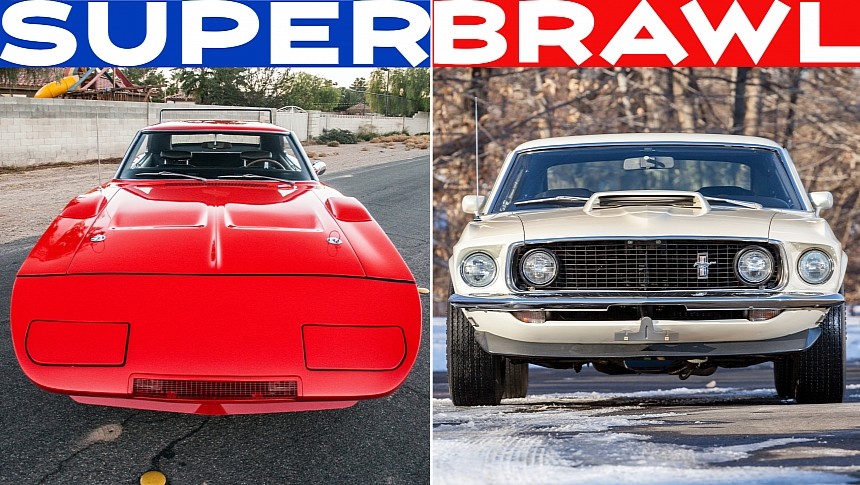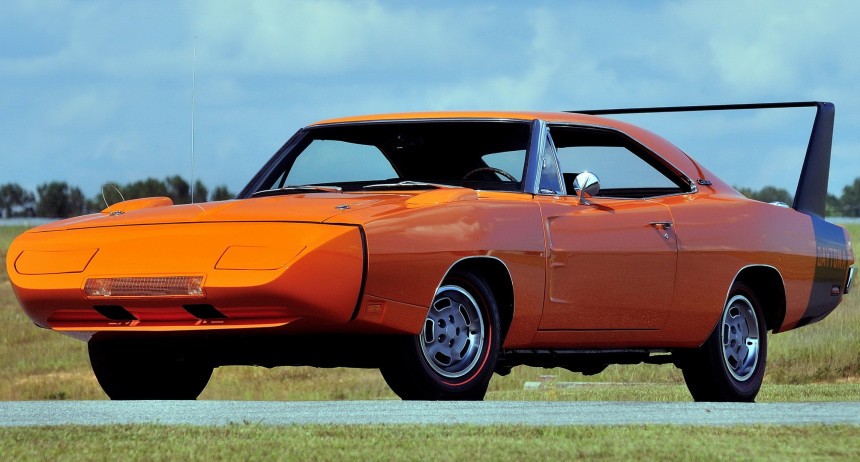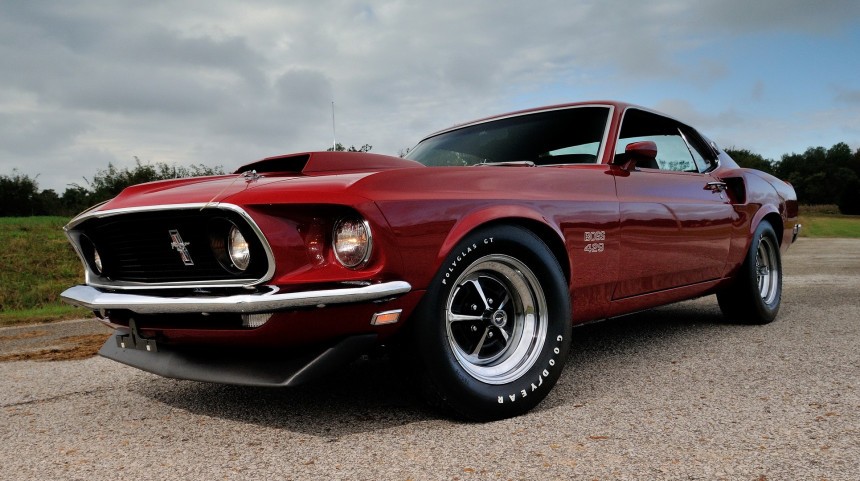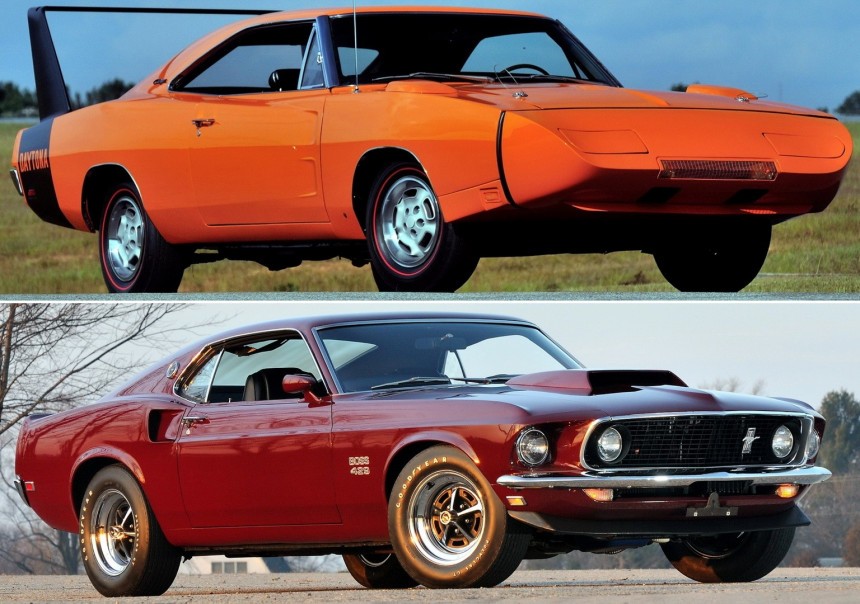After a tough Final Four round, the time has finally come to crown our all-time best classic American muscle car. It’s a direct battle between Ford and Dodge, between two NASCAR-adjacent vehicles that have since become both famous and infamous.
In one corner, we’ve got the Winged Warrior, a car that broke motorsport records on the track, and won hearts on the streets. It is, of course, the Dodge Charger Daytona, which to get here has had to dispatch the following legends: 1968 Oldsmobile Hurst/Olds 442, 1969 Dodge Charger R/T, 1970 Dodge Challenger R/T, and finally the 1970 Plymouth Superbird.
Meanwhile, in the other corner stands the 1969 Ford Mustang Boss 429, with its “semi-Hemi” engine – fun nickname. This brawler took out the 1970 Ford Torino GT Cobra 429, the 1970 Boss 429 Mustang, the 1969 Mustang Mach 1, and the 1969 Chevy Nova Yenko/SC.
Before we get into the match, let’s consider what would have happened if the Superbird and the Nova Yenko/SC had made the “Super Brawl”. We know that the Nova would have been the rarer car, with only 37 units known to have been produced. It would have also been quicker to 60 mph, compared to the Superbird, although the latter would have eventually caught up thanks to its superior aerodynamics.
You know what, I’ll leave that one up to you guys, because right now we’ve got bigger fish to fry, so let’s jump in, shall we?
This car represented one of those rare instances where function dominated over form. Its nose cone looked like something that was cut by Darth Vader’s lightsaber, but for good reason. The key word was ‘aerodynamics’ and this American classic cut through the air like a champ thanks to its .29 cd (drag coefficient).
Let’s not forget that Dodge would have probably never have built the Charger Daytona had the Charger 500 not failed so miserably on the racetrack. In 1968, the Charger 500 only managed to secure one race victory, to go with 17 Top-10 finishes and zero poles. It also finished 30th at the Daytona 500 that year, which was sort of embarrassing.
The Charger Daytona fixed all that, mostly thanks to a 23-inch stabilizing wing mounted on the trunk lid, which created all the downforce needed to keep the car securely planted on the track. It looked weird, but it worked.
As a result, this became the first stock car to ever hit 200 mph, but not before Buddy Baker crushed the opposition that year. Meanwhile, in 1970, Bobby Isaac would take his #71 Charger Daytona to 11 race wins, 13 poles and 38 Top-10 finishes, clinching the title for Dodge. It’s too bad Richard Petty never got to race in the Charger Daytona, ending up with its sister-car, the Plymouth Superbird.
Out of the 500+ Charger Daytonas thought to have been produced by Dodge, only 70 are known to have been fitted with the 426 ci Hemi V8 engine. That’s the configuration you want if you’re a collector. Actually, any configuration will do, because these things are crazy valuable today. Also, some believe that far fewer than 500 units were built, which makes for a fun little conspiracy.
When they first announced the car, they received over 1,000 orders, and they knew they had to build at least 500 in order to cover the NASCAR homologation requirements. What’s the conspiracy theory? Well, some people think that only 120 or so cars were actually built, with Dodge then using VINs from non-Daytona Chargers in order to meet the quota. Someone call Agent Mulder.
Like the Charger Daytona, the Boss 429 owes its existence to motorsport. Both Boss-spec Mustangs do, the Boss 302 and the 429. The former was built to homologate the 302 ci V8 engine for SCCA racing, whereas the latter for NASCAR. This is also why they made fewer Boss 429 models, because NASCAR regulations permitted carmakers to produce fewer cars, whereas the SCCA required 1,000 units to be mass-produced.
To say that the Boss 429 engine was a success would be an understatement. It dominated NASCAR in 1969 to the tune of 26 race wins. It would have probably gotten a lot more if Ford didn’t decide to pull their stock car racing funding.
Responsible for the design of the Boss 429 Mustang was one Larry Shinoda, known for keeping his ears to the ground with regards to hot rods and car mods.
As for the engine, it featured a hemispherical “crescent” combustion chamber, hence the nickname “semi-Hemi”, aluminum cylinder heads, separate cooling circuits for said heads and engine block, and a horsepower figure that is believed to have been misrepresented. Officially, Ford claimed 375 horsepower for the Boss 429 engine, to go with 450 lb-ft of torque.
Seeing as how the Boss 302 would frequently score 25 horsepower over stock on the dyno, some believe the same could be said about the Boss 429, giving it roughly 400 horsepower. Then there are those who think these flagship Mustangs produced as much as 500 horsepower, but there’s literally no proof to that. Besides, if they really did have 125 hp more than advertised, industry specialists would have figured it out quickly.
Other mods pertaining to the Boss 429 Mustang include the wider control arm, restructured shock towers, heavy duty shocks and sway bars, standard power front disc brakes, a close-ratio four-speed manual gearbox, small chin spoiler, plus a large (and functional) hood scoop.
“Here’s a street machine that’s certain to turn heads and bring ‘victory lane’ crowds into your dealership’s performance corner... the new Boss 429 Mustang SportsRoof.”
“Available with Mustang’s new ‘Grabber Blue’ exterior capped by a unique racing black hood scoop, with an all-white interior, and powered by the competition-proved 429 Boss V8 engine, this all-out performer features many standard items and options normally seen only at the local tracks or drag strips.”
This is from an official Boss 429 brochure, albeit one that represents the 1970 model year car, which had already undergone certain styling changes. Still, it helps paint a picture of how Ford viewed these cars during their 2-year run.
While a direct comparison between the Charger Daytona and the Boss 429 Mustang isn’t exactly an apples and oranges type of deal, conceptually these are two different breeds of muscle car.
One is meant to represent street culture and drag strips, whereas the other is meant to be more of a genuine race car. The Charger Daytona’s Hemi V8 engine is more powerful, at least on paper – it's got 425 horsepower and 490 lb-ft of torque, whereas the Boss 429 Mustang can only muster 375 horsepower (unless it really is more like 400 hp), to go with 450 lb-ft of torque.
The Dodge is the better performer, and it’s more valuable to collectors today, although to be fair, the Boss 429 is also crazy expensive to purchase at auction.
But what about looks? I think the Daytona is a stunning car, but its design is more of an acquired taste. It’s got a few quirky angles, so it’s definitely not for everybody, which is why I’m inclined to give the Mustang the edge in this department.
If you’re in the market for a Daytona, odds are you’re not even exposing it to the elements. It would spend its days in storage or on display somewhere. Meanwhile, a Boss 429 Mustang probably wouldn’t be so caged in. Sure, you can store them, but on rare occasions, people do drive them still – and not just the John Wick types.
Should we call it then? Alright, let’s call it. Deep breath.
Winner: 1969 Ford Mustang Boss 429
Meanwhile, in the other corner stands the 1969 Ford Mustang Boss 429, with its “semi-Hemi” engine – fun nickname. This brawler took out the 1970 Ford Torino GT Cobra 429, the 1970 Boss 429 Mustang, the 1969 Mustang Mach 1, and the 1969 Chevy Nova Yenko/SC.
Before we get into the match, let’s consider what would have happened if the Superbird and the Nova Yenko/SC had made the “Super Brawl”. We know that the Nova would have been the rarer car, with only 37 units known to have been produced. It would have also been quicker to 60 mph, compared to the Superbird, although the latter would have eventually caught up thanks to its superior aerodynamics.
You know what, I’ll leave that one up to you guys, because right now we’ve got bigger fish to fry, so let’s jump in, shall we?
Dodge Charger Daytona
Let’s not forget that Dodge would have probably never have built the Charger Daytona had the Charger 500 not failed so miserably on the racetrack. In 1968, the Charger 500 only managed to secure one race victory, to go with 17 Top-10 finishes and zero poles. It also finished 30th at the Daytona 500 that year, which was sort of embarrassing.
The Charger Daytona fixed all that, mostly thanks to a 23-inch stabilizing wing mounted on the trunk lid, which created all the downforce needed to keep the car securely planted on the track. It looked weird, but it worked.
As a result, this became the first stock car to ever hit 200 mph, but not before Buddy Baker crushed the opposition that year. Meanwhile, in 1970, Bobby Isaac would take his #71 Charger Daytona to 11 race wins, 13 poles and 38 Top-10 finishes, clinching the title for Dodge. It’s too bad Richard Petty never got to race in the Charger Daytona, ending up with its sister-car, the Plymouth Superbird.
Out of the 500+ Charger Daytonas thought to have been produced by Dodge, only 70 are known to have been fitted with the 426 ci Hemi V8 engine. That’s the configuration you want if you’re a collector. Actually, any configuration will do, because these things are crazy valuable today. Also, some believe that far fewer than 500 units were built, which makes for a fun little conspiracy.
When they first announced the car, they received over 1,000 orders, and they knew they had to build at least 500 in order to cover the NASCAR homologation requirements. What’s the conspiracy theory? Well, some people think that only 120 or so cars were actually built, with Dodge then using VINs from non-Daytona Chargers in order to meet the quota. Someone call Agent Mulder.
Ford Mustang Boss 429
To say that the Boss 429 engine was a success would be an understatement. It dominated NASCAR in 1969 to the tune of 26 race wins. It would have probably gotten a lot more if Ford didn’t decide to pull their stock car racing funding.
Responsible for the design of the Boss 429 Mustang was one Larry Shinoda, known for keeping his ears to the ground with regards to hot rods and car mods.
As for the engine, it featured a hemispherical “crescent” combustion chamber, hence the nickname “semi-Hemi”, aluminum cylinder heads, separate cooling circuits for said heads and engine block, and a horsepower figure that is believed to have been misrepresented. Officially, Ford claimed 375 horsepower for the Boss 429 engine, to go with 450 lb-ft of torque.
Seeing as how the Boss 302 would frequently score 25 horsepower over stock on the dyno, some believe the same could be said about the Boss 429, giving it roughly 400 horsepower. Then there are those who think these flagship Mustangs produced as much as 500 horsepower, but there’s literally no proof to that. Besides, if they really did have 125 hp more than advertised, industry specialists would have figured it out quickly.
Other mods pertaining to the Boss 429 Mustang include the wider control arm, restructured shock towers, heavy duty shocks and sway bars, standard power front disc brakes, a close-ratio four-speed manual gearbox, small chin spoiler, plus a large (and functional) hood scoop.
“Here’s a street machine that’s certain to turn heads and bring ‘victory lane’ crowds into your dealership’s performance corner... the new Boss 429 Mustang SportsRoof.”
“Available with Mustang’s new ‘Grabber Blue’ exterior capped by a unique racing black hood scoop, with an all-white interior, and powered by the competition-proved 429 Boss V8 engine, this all-out performer features many standard items and options normally seen only at the local tracks or drag strips.”
This is from an official Boss 429 brochure, albeit one that represents the 1970 model year car, which had already undergone certain styling changes. Still, it helps paint a picture of how Ford viewed these cars during their 2-year run.
Who’s the real boss?
One is meant to represent street culture and drag strips, whereas the other is meant to be more of a genuine race car. The Charger Daytona’s Hemi V8 engine is more powerful, at least on paper – it's got 425 horsepower and 490 lb-ft of torque, whereas the Boss 429 Mustang can only muster 375 horsepower (unless it really is more like 400 hp), to go with 450 lb-ft of torque.
The Dodge is the better performer, and it’s more valuable to collectors today, although to be fair, the Boss 429 is also crazy expensive to purchase at auction.
But what about looks? I think the Daytona is a stunning car, but its design is more of an acquired taste. It’s got a few quirky angles, so it’s definitely not for everybody, which is why I’m inclined to give the Mustang the edge in this department.
4th & Goal
Making the ultimate decision between these two classics comes down to the way you approach the issue. If we’re talking about the “rare factor” and overall value for collectors, you’d be inclined to have the Charger Daytona as your winner. But would you really approach it that way seeing as how popularity is so important? I’m thinking, no.If you’re in the market for a Daytona, odds are you’re not even exposing it to the elements. It would spend its days in storage or on display somewhere. Meanwhile, a Boss 429 Mustang probably wouldn’t be so caged in. Sure, you can store them, but on rare occasions, people do drive them still – and not just the John Wick types.
Should we call it then? Alright, let’s call it. Deep breath.
Winner: 1969 Ford Mustang Boss 429













